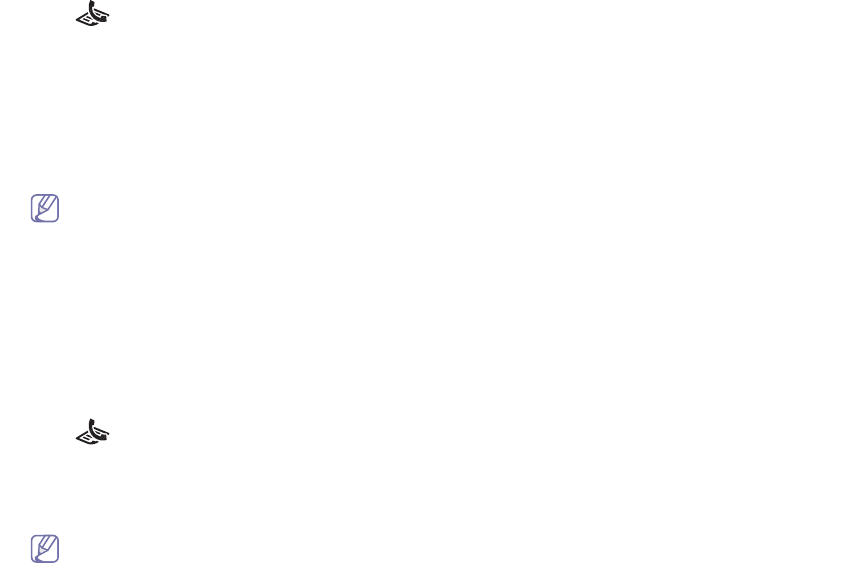
Faxing_ 37
Receiving faxes using DRPD mode
Distinctive Ring is a telephone company service which enables an user to use a single telephone line to answer several
different telephone numbers. The particular number someone uses to call you is identified by different ringing patterns,
which consist of various combinations of long and short ringing sounds. This feature is often used by answering services
who answer telephones for many different clients and need to know which number someone is calling in on to properly
answer the phone.
Using the Distinctive Ring Pattern Detection (DRPD) feature, your fax machine can le
arn the
ring pattern you designate to
be answered by the fax machine. Unless you change it, this ringing pattern will continue to be recognized and answered as
a fax call, and all other ringing patterns will be forwarded to the extension telephone or answering machine plugged into the
EXT socket. You can easily suspend or change DRPD at any time.
Before using the DRPD option, Distinctive Ring service must be instal
led on your telephone line by the telephone
company. To set up DRPD, you will need another telephone line at your location, or someone available to dial your fax
number from outside.
To set up the DRPD mode:
1. Press
(Fax) on the control panel.
2. Press Menu un
til Fax Setup appears.
3. Press the left/rig
ht arrow until DRPD Mode appears and press OK.
Waiting Ring appears on the disp
lay.
4. Call your fax numb
er from another telephone. It is not necessary to place the call from a fax machine.
5. When your machine begins to ring, do not answer the call. T
he machine requires several rings to learn the pattern.
When the machine completes learning, the display shows End DRPD [
Setup]. If the DRPD setup fails, DRPD Ring
Error appears.
Press OK when DRPD appears and start over from step 3.
• DRPD must be set up again if you re-assign your fax number, or connect the machine to another telephone
line.
• After DRPD has been set up, call your fax number again to verify that the machine answers with a fax tone.
Then have a call placed to a different number assigned to that same line to be sure the call is forwarded to
the extension telephone or answering machine plugged into the EXT socket.
Receiving in secure receiving mode
You may need to prevent your received faxes from being accessed by unauthorized people. You can turn on secure
receiving mode to restrict printing of received faxes when the machine is unattended. In secure receiving mode, all
incoming faxes go into memory. When the mode is deactivated, any stored faxes are printed.
Activating secure receiving mode
1. Press (Fax) on the control panel.
2. Press Menu un
til Advanced Fax appears.
3. Press the left/rig
ht arrow until Secure Receive appears and press OK.
4. Press the left/rig
ht arrow until On appears and press OK.
5. Enter a four-digit passwo
rd you want to use and press OK.
You can activate secure receiving mode without setting a password, but cannot protect your faxes.
6. Re-enter the password to confirm it and press OK.
7. Press St
op/Clear to return to ready mode.
When a fax is received in secure receiving mode, your machine stor
es it in memory and shows Secure Receive to let you
know that there is a fax received.
Printing received faxes
1. Access the Secure Receive menu by following steps 1 through 3 in “Activating secure receiving mode.”
2. Press the left/right arrow until Pr
int appears and press OK.
3. Enter the four-digit password and press OK.
The machine prints all of the faxes stored in memory.
Deactivating secure receiving mode
1. Access the Secure Receive menu by following steps 1 through 3 in “Activating secure receiving mode.”
2. Press the left/right arrow until Of
f appears and press OK.
3. Enter the four-digit password and press OK.
The mode is deactivated and the machine prints all faxes sto
r
ed in memory.
4. Press S
top/Clear to return to ready mode.
Receiving faxes in memory
Since your machine is a multi-tasking device, it can receive faxes while you are making copies or printing. If you receive a
fax while you are copying or printing, your machine stores incoming faxes in its memory. Then, as soon as you finish
copying or printing, the machine automatically prints the fax.


















